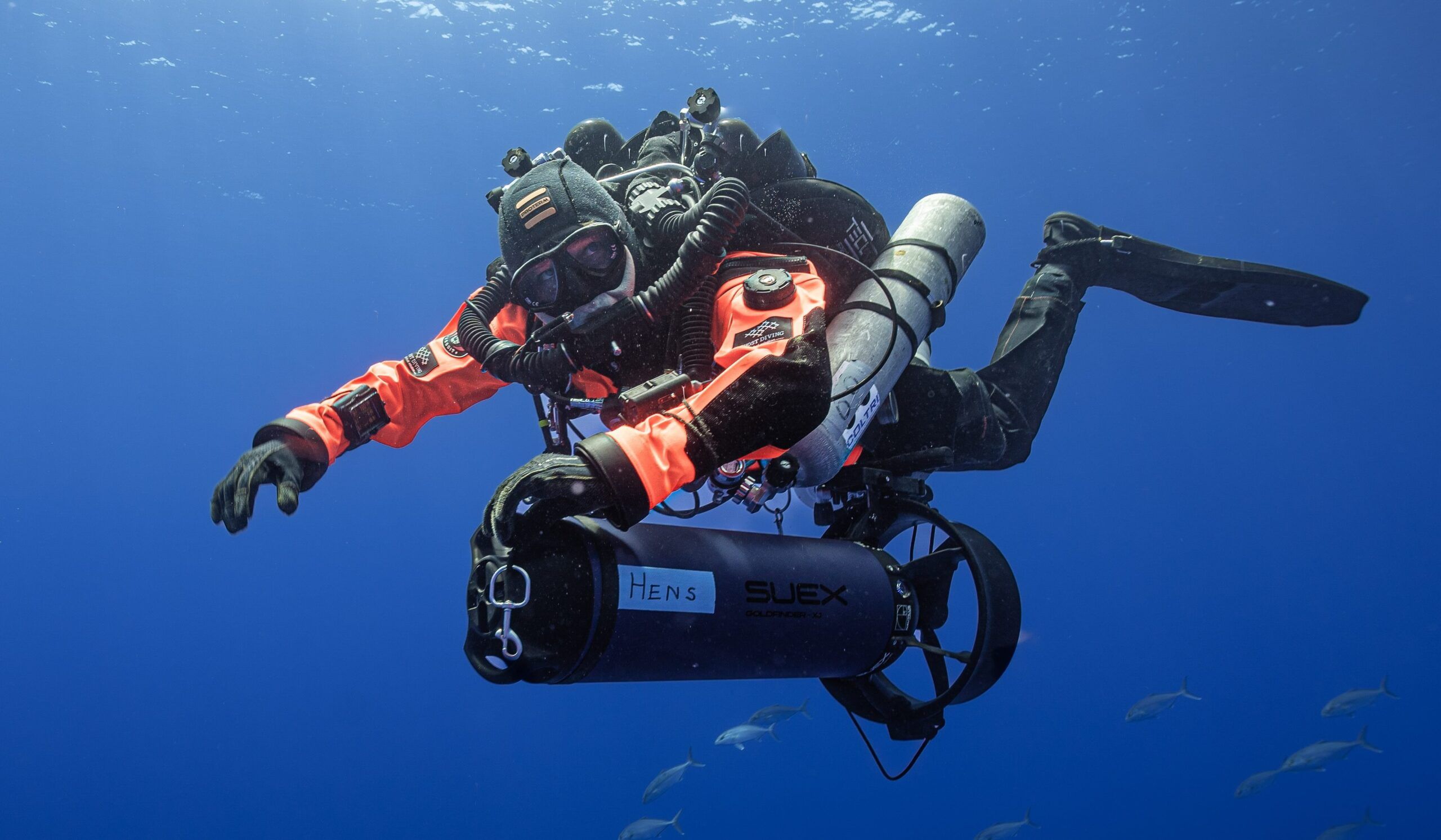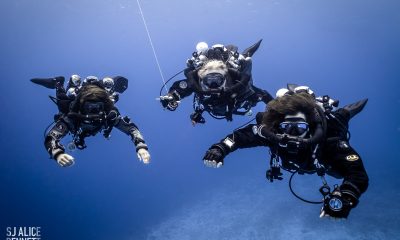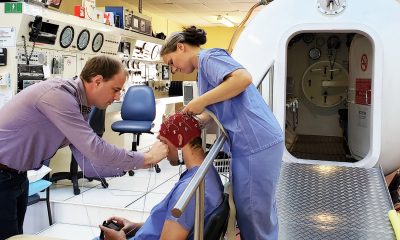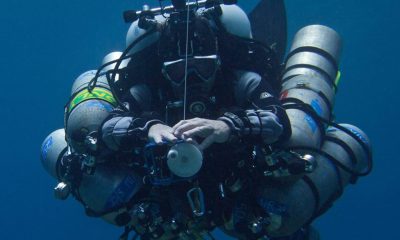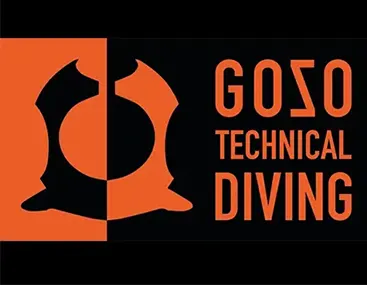Community
Undergoing PFO Surgery as a Team: Deana & Bert’s Excellent Adventure
People like to give GUE a hard time for their uncompromising focus on team diving. But a pair of divers from GUE Seattle has taken it to a new level: getting their PFOs fixed together. The team that bends together, mends together? Instructor and tech diver James D. Fraser willingly tells the tale.
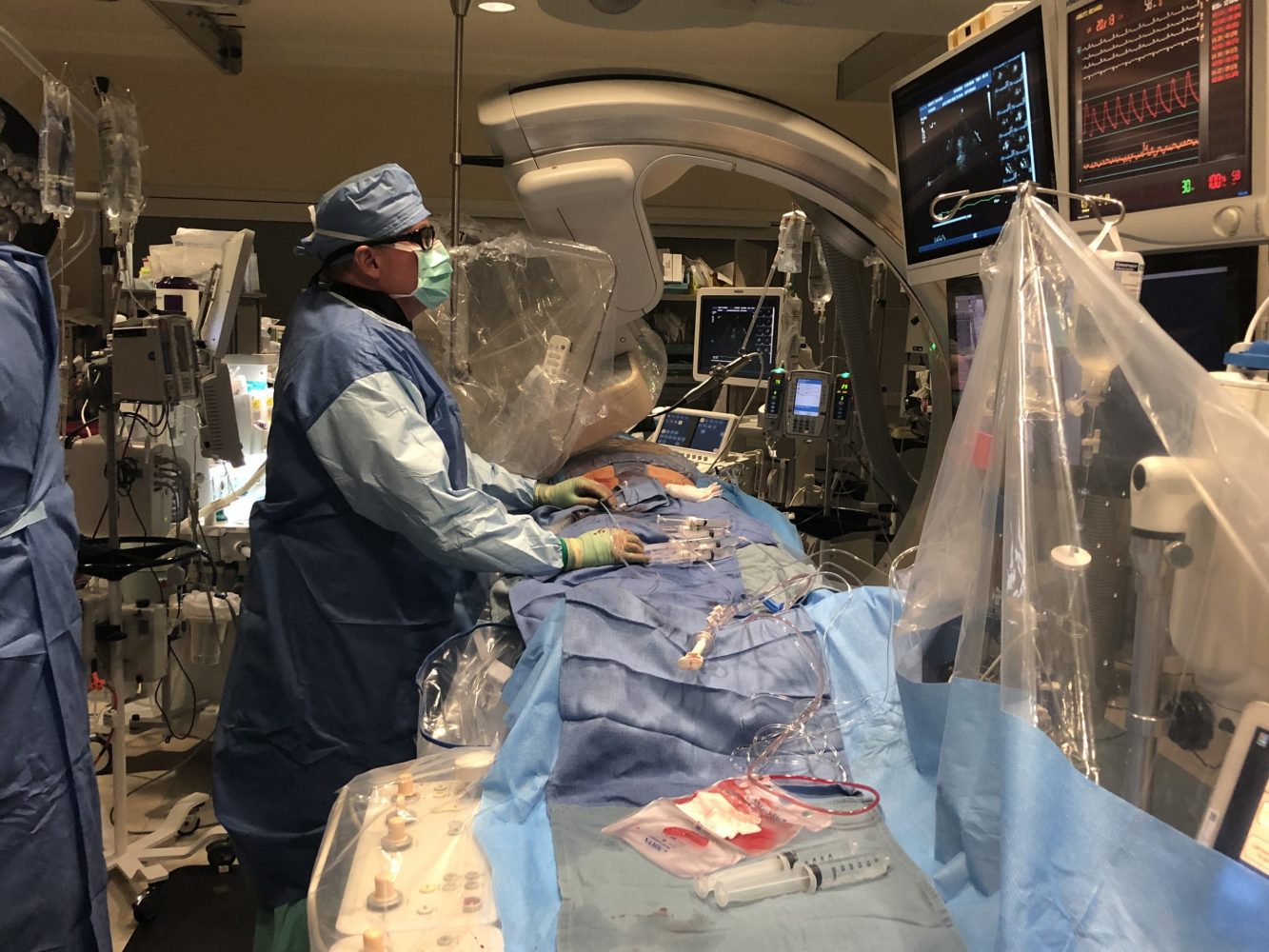
by James D. Fraser
Header photo courtesy of Dr. Doug Ebersole
This is the follow-up to the story that ran in InDepth December, 2019: No Fault DCI? The Story of My Wife’s PFO
It has been a year since my wife Deana had a decompression illness (DCI) hit in Bonaire requiring her to do a Table 5 recompression profile in a hyperbaric chamber. At the time of my previous article’s publication, Deana had a Transthoracic Echocardiogram (TTE) bubble study and found out she did have a small to moderate patent foramen ovale (PFO). Two physicians offered similar options for Deana to consider when it came to her diving activities:
- Stop diving, as this eliminates any risk of DCI in the future.
- Modify her dive profiles to be more conservative: diving only once per day, diving nitrox 32 using air tables, and/or extending her decompression profiles and safety stops.
- Have the PFO repaired, knowing it is not a guarantee, and continue diving as conservatively as possible.
Deana had initially decided to wait on doing a PFO closure until after our daughter’s wedding in March 2020, but she realized very quickly that being “conservative” was not in her nature. Deana had already returned to diving within 12 days of her hyperbaric chamber ride. In the 46 days since her treatment, Deana had already done another 15 dives to depths of 90 feet; being conservative really was proving to not be an option for her. Diving was just too much a part of her life.
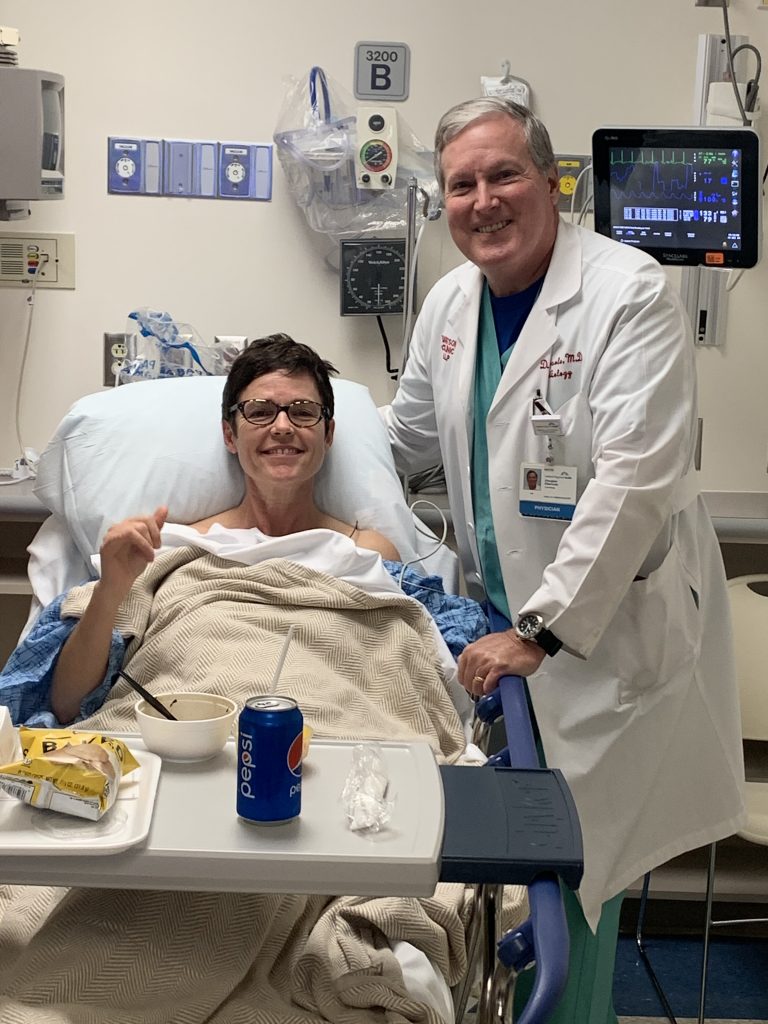
In mid-November, Deana reached out to cardiologist and tech diving instructor Dr. Doug Ebersole for a second opinion on the bubble study and his advice about her options. Dr. Ebersole gave Deana the same response as the other physicians; but, knowing Deana and her passion for diving, he suggested that she have her PFO fixed, since her plan was to continue diving.
Deana also spent time talking to other divers who had been diagnosed with PFOs—some who had them repaired and some who had decided against it—in order to get a more complete picture from both a patient and a doctor point of view. One of the final conversations that pushed Deana to have her PFO repaired was with a coworker who was a nurse practitioner in cardiology with knowledge of PFOs and diving. Her coworker was pretty blunt, stating, “Why are you playing Russian Roulette? You have worked in cardiac and know the risks.”
Some of these risks include Arterial Gas Embolism (AGE), Venous Gas Embolism (VGE), and cerebral embolism. That was the final “Aha” moment to tip the scale and get Deana to schedule her PFO repair, since “Russian Roulette” was exactly what Deana was doing based on her diving activities following her DCI hit.
Team Approach to Treatment
Bert Berzicha, one of our GUE Seattle community members, also completed his TTE as a result of having had some symptoms of DCI in the past. The test confirmed the presence of a large PFO. Deana and Bert compared notes initially and discussed diving as a team on future dives using more conservative decompression profiles than other teams, allowing the other teams to get out of the water sooner. Deana, however, related what she had learned from talking with her coworker and changed her mind about diving conservatively and instead decided to get the PFO repaired.

Deana did not want to take the risk of neurological deficits that could be irreversible. Deana suggested to Bert that he come with her to have his PFO repaired at the same time. Bert continued to research the subject, looked at his work schedule, and decided doing a “team” procedure made sense. Just as a dive team shares a plan, resources, and emergency procedures, a medical procedure shares similar benefits when working as a team.
It was time to plan a date for both of them to have the procedure. Deana and Bert both live in the Seattle area. Dr. Ebersole lives in Lakeland, Florida, so logistics included time off work, pre- and post-surgical care, flights, hotels, and transportation. Deana arranged to have her sister Jessica fly into Tampa from Dallas, prior to them arriving, so she could pick them up from the airport to make it to the hospital in time for the procedure. I was going to be in Australia on a business trip at the time, so I was not able to be there pre-surgery. I ended up reworking my return trip and flew from Canberra, AU to San Francisco, then on to Tampa, to land just an hour after their surgeries were finished and meet them back at the hotel.
Even though Deana and Bert could fly home 24 hours after the procedure, they decided to stay the weekend just in case there were any complications and to take it easy. Deana, however, had a different take on “easy.” The morning after surgery, Deana was invited by Dr. Ebersole to watch a procedure that he and his team perform called the “WATCHMAN” procedure (less than 24 hours after post-op). Then we picked up Bert and Jessica, and jumped into the truck to do a 300-mile, five-hour road trip to High Springs, FL, to take a tour of the Halcyon facility and say “Hi” to Orie Braun, Lauren Fanning, and Mark Messersmith; stop in at Global Underwater Explorers (GUE) HQ to buy some swag; and drive down to Ginnie Springs to see where Cave 1 may take place in Deana’s and my near future. Not bad a day after surgery.

It was at Ginnie Springs where Bert came to Deana and stated he thought he had active bleeding. We all paused and turned pale, knowing we were not in a great location for this to be happening, but after being assessed by Deana it turned out to be post-op bruising from the surgery. This did, however, make us stop and think, “We just drove 300 miles away from the hospital we had decided to be close to in case of complications.” I am sure Gareth Lock would find a really good human factors story in there somewhere.
Deana’s PFO adventure Timeline
2019
- OCT 8: 47 m/153 ft technical dive resulting in a DCI episode requiring recompression.
- OCT 20: First dive post-chamber ride to 16 m/52 ft
- OCT 29: TTE Bubble Study; “Deana has a small to moderate PFO”
- NOV 17: Dr. Ebersole receives Deana’s TTE study for a second opinion
- NOV 21: Deanna dives now to 28 m/90 ft
- DEC 4: Last dive before PFO repair. In the 46 days since her hyperbaric treatment Deana made 15 dives: “Conservative Not”
- DEC 12: Deana and Bert have PFO procedure
- DEC 13: Lakeland to High Springs road trip
2020
- JAN 27: First dive post closure—15 m/49 ft and spaced dives 2-3 days apart
- FEB 15: Started doing multiple dives daily no greater 15 m/50 ft
- MAR 8: PFO follow-up; OFFICIALLY cleared by Dr Ebersole to dive
- MAY 7: Dives now pushing 30 m/100 ft
- MAY 31: First Tec dive to 33 m/110 ft
Since May, Deana has done 120 dives in 2020 with a max depth of 52 m/170ft, which she did on September 12. Deana has gone back to no-restriction diving and has completed 16 technical dives since this summer. Some of these have been assisting with photogrammetry dives.
- 46 m/150 ft to 52 m/170 ft: 3 dives
- 40 m/130 ft to 46 m/150 ft: 5 dives
- 30 m/100 ft to 40 m/130 ft: 8 dives
Getting Personal With PFOs
COVID-19 has prevented us from doing a dive trip this year, which is the one main test we still have yet to do: repeat the scenario that always led to her getting DCI, which was three consecutive days of recreation and tech dives, to see if she experiences any recurrence of DCI symptoms. 2021 will hopefully open up this opportunity, or by that time Deana will already be training for GUE’s Tech 2 course. In either case, Deana and Bert are both very happy to have had their PFOs repaired; both have seen improvements in their health in other areas such as endurance, no longer being easily winded, and, in Bert’s case, less headaches, which he had prior to the PFO closure.

To get a PFO repaired is a personal choice, and no one should ever take surgery lightly as it has its own risks. Divers with PFOs need to do their own research and consult an interventional cardiologist, such as Dr. Ebersole, who understands diving. Only then can they make an informed choice based on their own unique situation whether or not a PFO closure is right for them. This article is meant to show the process and outcome of two very experienced and ambitious divers who made the choice to have their PFO repaired and the results of that decision.

Dive Deeper
Diving and Hyperbaric Medicine: The effectiveness of risk mitigation interventions in divers with persistent (patent) foramen ovale by George Anderson, Douglas Ebersole, Derek Covington and Petar J Denoble. 2019 Jun 30.
Alert Diver: PFO Study Update by Petar J Denoble
Alert Diver: Cases studies of divers who had their PFOs closed with transcatheter-applied occluders: Divers with Holes in their Hearts by Petar J Denoble 2010

James D. Fraser is a GUE Fundamentals and Rec 1/2 Instructor, PADI MSDT, and NAUI Scuba Instructor, and has been diving in the Pacific Northwest for over 30 years. James currently lives in Seattle, WA, with his wife and dive teammate Deana Fraser. As a member of the GUE Seattle Board of Directors, James is able to share his experiences and work with Deana at growing the local diving community sharing their passion with all who are interested. James recently embraced technical diving, becoming certified as a Technical 1 diver with GUE. James and Deana have had opportunities to travel all over the world to experience their passion in amazing places such as Egypt and the Maldives. James currently works as a Cyber Security Director with a Fortune 500 Defense Contractor and has been a residential construction business owner and Emergency Medical Technician (EMT).


















